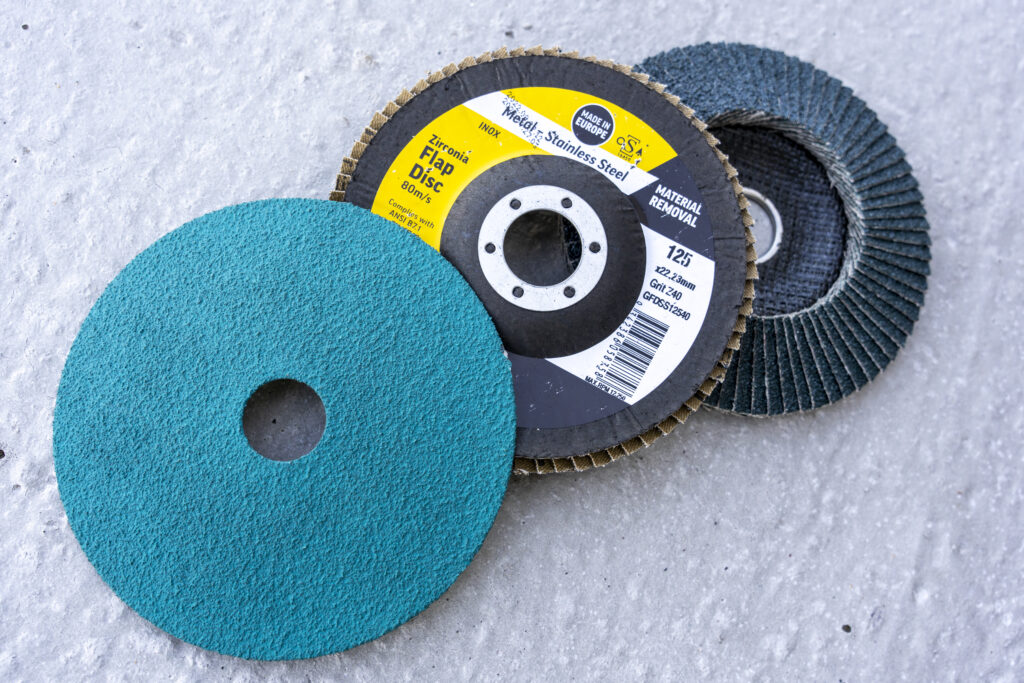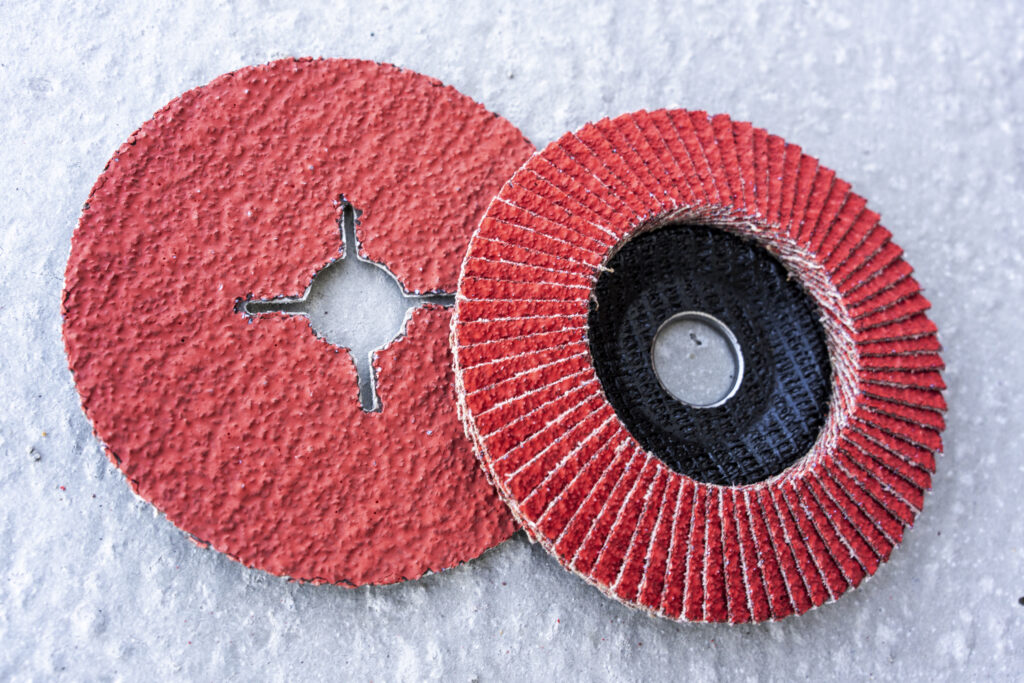Alpha has a whole range of abrasives from cut-off wheels, grinding wheels, flap discs, coated abrasives with backing pads, R-Type and S-Type discs as well as a range of polishing and finishing discs. But first off…
What are abrasives?
Abrasives are materials used in various industries and applications to wear away or remove unwanted material from surfaces. They are typically hard and have sharp edges, which allows them to scrape, grind, or polish other materials when applied with pressure.
Commonly used in manufacturing, construction, metalworking, woodworking, and various other fields, abrasives serve several purposes, including:
1. Grinding: Abrasives are used to grind down material and create a smooth surface or to shape objects to the desired form.
2. Cutting: Some abrasives can be used as cutting tools, particularly in the form of abrasive discs or blades. They can cut through materials like metal, stone, or concrete.
3. Polishing: Finer abrasive materials, such as sandpaper or polishing compounds, are used for polishing and finishing surfaces to achieve a smooth and reflective appearance.
4. Cleaning: Abrasives can also be used for cleaning surfaces by removing rust, paint, or other unwanted coatings.
Abrasives come in various forms, including natural, synthetic, bonded and coated. Alpha specialises in coated abrasives where abrasive particles are attached to a backing material, such as sandpaper or abrasive belts.
Selecting the right abrasive for the right job depends on the specific application, the hardness of the material, and the required finish.
How do abrasives work?
1. Abrasive grain cuts the workpiece:
When an abrasive material, such as sandpaper, grinding wheels, or abrasive belts, meets the workpiece's surface, the abrasive grains act like tiny cutting tools. These grains are extremely hard and sharp, and they apply concentrated force to the workpiece, causing the material to be removed.
2. Some of the grain is sacrificed and discarded along with the removed material:
As the abrasive grain cuts into the workpiece, some of the grain itself wears down and breaks apart due to the pressure and friction involved. This process is purposefully designed, and a certain degree of grain wear is expected during the process.
3. When the old grain is broken off, new fresh grain is exposed:
As the old abrasive grains wear down or break off, new sharp grains underneath them are revealed. This process of continuously exposing fresh abrasive grains ensures that the abrasive surface remains effective and helps to maintain a consistent cutting edge.
4. The better-quality grain, the more efficient the process:
The efficiency of the process depends on the quality of the abrasive grain used. High-quality abrasive grains are made from strong and durable materials which ensure they maintain their sharpness and hardness for a longer time. Cheaper or lower-quality abrasives may wear out quickly, reducing their cutting ability.
5. Resulting in higher stock removal and finish:
With the combination of sharp and hard abrasive grains and the continuous exposure of new grain during the process, the workpiece's surface experiences significant material removal. This higher stock removal rate allows for faster material shaping, grinding, or polishing. Also, the use of quality abrasive grains contributes to a smoother finish on the workpiece.
What abrasive coating for what application?
There are four abrasive coatings that Alpha focuses on, Soft Metal, Aluminium Oxide, Zirconia and Ceramic.
Soft Metal
Soft Metal abrasives are aptly named for quickly and efficiently cutting soft metals.

Often a deep red or burgundy colour these discs are ideal for grinding, cutting and polishing back bronze, brass and aluminium.
One of the features of soft metal abrasives is their self-lubricating property during the grinding process. This means that as the disc grinds against the metal surface, it releases a lubricating substance that reduces friction and heat build-up. As a result, the metal does not overheat, and the abrasive disc remains cooler during use. This self-lubricating feature not only enhances the longevity of the abrasive disc but also ensures a consistent and controlled cutting performance.
Another advantage of using soft metal abrasives is their ability to handle lower work surface temperatures. Soft metals are more sensitive to heat, and traditional abrasives might generate excessive heat during grinding or cutting, potentially damaging the metal or reducing the tool's effectiveness. However, with soft metal abrasives, the controlled temperature allows for safer and more precise metalworking.
The open coat structure of these discs helps prevent loading. Loading is the accumulation of metal debris, dust, or other materials on the surface of the abrasive, which can limit its cutting power. The open coat design enables the disc to shed debris effectively, maintaining its cutting efficiency for longer periods.
Key Takeaways:
- Self-lubricating whilst the disc is grinding to delay disc loading
- Lower work surface temperature
- Discs act as an open coat, shedding any build-up debris
- Ideal for use on bronze, brass and aluminium
- Suitable for cordless drills
Aluminium Oxide
Aluminium oxide is a tough durable grain used for cutting, grinding and finishing in metal, wood and coatings.

Aluminium oxide is the most common and cost-effective abrasive grain in the industry and is usually a brown colour. It is suitably used in both large-scale metalworking and woodworking tasks. Aluminium oxide abrasives offer great performance and value for everyday metal tasks.
These abrasives are perfect for general metal work, making them an excellent choice for tradies who work on mild steel projects. Despite being a cheaper alternative, their quality remains uncompromised, and the durable tough grain ensures consistent and reliable performance.
Alpha's aluminium oxide products are compatible with cordless tools, enhancing their versatility and making them a practical option for quick, daily applications. While they may experience a reduction in sharpness over time due to low friability, their cost-effectiveness makes them a practical solution for various projects.
Key Takeaways:
- Tough durable grain
- Cost-effective
- Better performance on mild metal and steel
- Can be used on cordless tools
- Can go dull after a while due to low friability.
Zirconia Alumina

Zirconia alumina is a tough durable grain with fine crystal structures used for rugged stock removal of metal and wood. 
Zirconia abrasives, often a blue colour, are in a higher price range than aluminium oxide and are highly effective for coarse to medium grit metal work applications. They outperform even under higher temperatures and pressures, providing accurate refinement of sharp edges. The presence of zirconia alumina further enhances these abrasives' self-sharpening properties, making them a preferred choice in various industries, especially industries that work with stainless steel.
Zirconia abrasives outperform those abrasives that are designed solely for regular steel and metal applications. In comparison to aluminium oxide grains, zirconia abrasives exhibit significantly greater strength and superior performance owing to their remarkable heat resistance. This attribute makes them highly suitable for high-pressure machining and grinding applications, positioning them as a top choice in the steel fabrication industry.
Zirconia abrasives can have varying zirconia content, but Alpha’s zirconia products are 100 per cent zirconia, ensuring premium performance, particularly for heavier steel tasks.
It's important to note that when purchasing zirconia abrasives, cheaper options may have a lower zirconia content (around 60 per cent) and contain more aluminium oxide. This can be a problem when working with stainless steel, as aluminium oxide can get into welds and create impurities. To avoid such issues, it's important to choose a higher zirconia content.
Alpha abrasives are also suitable with a cordless drill, adding to their versatility and convenience.
Key Takeaways:
- Highly friable (new sharp edges)
- Slightly higher cost
- Effective for coarse to medium grit metal work applications
- Excellent with stainless steel applications and aluminium
- Performs well under higher temperatures
- Top choice for the steel fabrication industry
- Can be used on cordless tools
- Alpha Zirconia products are 100 per cent zirconia for premium performance
Ceramic Alumina 
Ceramic alumina is a tough durable grain with a very fine crystal structure that creates multiple cutting edges in each grain used for the highest stock removal in metal.
Ceramic grains have the longest lifespan and the fastest cutting rate among all abrasive grains, revolutionising machining industries. These abrasive grains consistently and aggressively cut under high pressure, remove incredible amounts of steel with very little force and are identified by their orange or red colour.
Ceramic abrasive grains feature a finely micro-crystalline structure, distinguishing them from aluminium oxide or zirconia abrasive grains.
The ceramic grains fracture during use, continually forming and exposing fresh sharp points that effortlessly slice through metal. This self-sharpening feature not only stays cool but delivers a consistent quality finish time and time again.
They are suitable for aggressive grinding and provide maximum and furiously fast stock removal with low heat generation which is perfect for heavy engineering, manufacturing, fabrication, metal work and machinist work.
Ceramic abrasives work well on aluminium castings, mild steel mill scale, stainless steel finishing, titanium alloys, metal grinding, rounding off pieces of steel, deburring heavy plates, cleaning weld seams, surface grinding and chamfering.
The best results are on high-powered angle grinders (1200 watts). Ceramics are unsuitable for small grinding or light metal work due to the furious grinding action. This can load up the grinder motor and quickly burn out a low-powered grinder.
Key Takeaways:
- Engineered for toughness and friability
- More cutting edges in each grain: self-sharpening
- Higher cost but long-life span
- Low heat generation
- Better performance on most materials
- Additional coating technology: soaps and anti-clogging agents to assist with performance
- Effective for medium to high grit metal work applications
- Furiously fast stock removal
- Perfect for heavy engineering, manufacturing, fabrication, metal work and machinist work.
- The best results are on high-powered angle grinders (1200 watts)